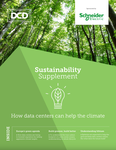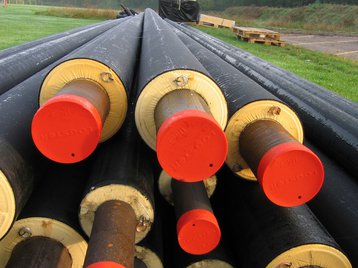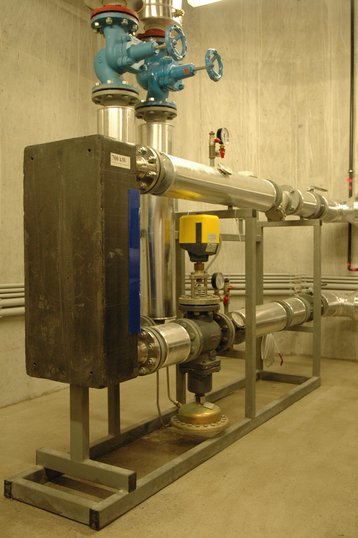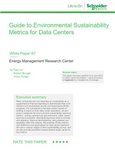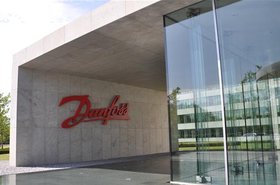Data center operators like to talk about heat reuse, but they probably talk about it more often than they actually do it. There are reasons for that, but all that could be about to change.
Let’s start with the basics. How much energy comes out of the data center as heat, how much is wasted, and what can you do with it?
The big picture
The short answer to the first question is is “all of it.” Energy is not consumed, but changes from one form to another. After performing other tasks, what is left is heat. So a 100MW data center will produce, more or less, 100MW of heat.
Data center efficiency measures that reduce power usage effectiveness (PUE) are aimed at driving more of that energy through the servers, so less is used for cooling, which means more computation is done per Watt. Once the energy is heat, any that is not wanted elsewhere is released and, effectively, wasted.
Data center efficiency, measured by PUE is reaching its practical limits, says Max Schulze head of the Sustainable Digital Infrastructure Alliance (SDIA): “Data centers did a good job over time reducing this number, It's about 1.2 to 1.4 in the modern data center, and I don't think we'll get more efficient than that. So the only way to reach the next level of efficiency is to use the heat.”
But who wants data center waste heat? Historically most data centers have found that no one else wants their waste heat. Its temperature is too low for them to see any value in it.
“What we want is digital services, but we also get low grade heat,” says Professor Jon Summers, research leader in data centers at RISE in Sweden. “It’s not sufficiently hot to do anything with, except a bit of space heating. Therein lies the problem.”
There are exceptions, one of which is Stockholm Data Parks, a 30MW campus near the center of Stockholm where data centers connect to a district heating system, which pays them for their hot air.
But only a small minority of facilities are in cities where there is a district heating system in place which can take their heat, and where the climate is cold enough that local homes and businesses need a lot of warming up.
“You can’t go to Africa and say to them ’you should do heat reuse’. It makes no sense,” says Schulze.
But the majority of data centers are in the wealthy countries in the Northern hemispheres, he says: “Most of the western world is in the northern hemisphere. So yes, we do need the heat. It is very valuable to us as a society.”
Despite this, heat reuse is often “greenwash”, where a company pays lip service to an idea, to look better, without any practical results. For instance, there are data centers in Schulze’s native Amsterdam, which are “heat recovery ready” but, he asks: “What does it mean? There is a pipe sticking out of the data center. Come on!”
That data center has made no real effort to get its heat used, he says.
It actually is hard to do
But, there are reasons why heat reuse is hard to do. Take the case of AQ Compute, the data center arm of Aquila Capital, which could not be more keen on energy reuse.
It’s partnering with efficient IT firm Cloud&Heat (of whom more later), which is building AQ's first data center in Oslo.
And yet, it’s proving tricky to negotiate the Oslo data center onto the local district heating system, admits AQ Compute CEO Petter M. Tømmeraas, a heat reuse enthusiast who formerly worked at Norway’s Green Mountain, as well as Basefarm.
“In Norway, heat reuse is a passion,” he says. “I’m also chair of the Norwegian Data Center industry Group, and we have working groups looking into it across the entire industry.”
So Tømmeraas checked out heat reuse at the planned Oslo facility: “Over a certain size, it’s a requirement in Norway to do a report on heat reuse. You have to at least have a look at it,” he says. “But I didn’t need to be forced to do this. I would really like to do it everywhere.”
The trouble is the costs are high, and it can make a data center uncompetitive, he said, “because other people will not do it”.
Despite the presence of a district heating system, Tømmeraas has yet to decide whether the economics work in favor of hooking up. “The first part of the data center will be cooled by indirect air to air systems, and that makes heat reuse more tricky than in water-based systems.”
It may turn out to be too difficult, he says, because: “We have air, and air is not a good source for heat. Transferring the heat to water, could lose efficiency.”
Encouraged by governments
Norway may be the only place to set formal requirements for heat reuse by data centers. But the measure, introduced in 2021, is only a demand that all data centers must examine the possibility and produce a report.
Many facilities might find it isn’t economically worthwhile, as was the case with AQ Compute.
Norway’s government wants data centers as a growing business sector. They are required to be green in order to be accepted by citizens, and pass muster with the country’s environmental plans.
That seems to be a pattern elsewhere. In urban areas data centers are a good source of tax revenue, but they need land, and power. Even if they select renewable energy, they can push renewable energy targets out of reach.
In Denmark, an influx of hyperscale data centers are all opting for green energy, leading to government predictions that there will be no renewable power left to meet its targets. Among the responses, the country has altered rules on the heat reuse, to encourage data centers to take part.
Amsterdam banned new data center projects for two years in 2019, a moratorium which seems to have hinged partly on heat reuse. Dutch data center operators had offered their heat but, as the SDIA’s Schulze describes, the responsibility for collecting lay elsewhere.
"We are going to set requirements in the area of making available residual heat free of charge for the heating of homes,” said Amsterdam’s Alderman for sustainability, Marieke van Doorninck.
But operators said they were already doing that. "In 2017, we said we would give [waste heat] for free, as a way to start discussion," said Judith De Lange of the Dutch Datacenter Association. Amsterdam data centers are built with heat reuse in mind, but it is offered on a "collect at the door" basis. Someone else has to pay to build the infrastructure to make use of the heat.
In 2021, the moratorium lifted, with a promise that the issue will be discussed further.
Frankfurt also clamped down on data centers somewhat, with a magistrate asking them to do something with their heat. The magistrate acknowledged the difficulty, that a temperature level of 30°C to 40°C is too low for most district heating networks. In Scandinavia heat pumps are used, to boost the temperature of waste heat, but that's not economical in Frankfurt, "due to the high energy prices in Germany."
Ireland currently faces a backlash against data centers, with utility Eirgrid due to restrict them in the Dublin area. Already, AWS has joined a district heating scheme there, offering heat to homes and offices in South Dublin.
With regulations pending, Europe’s data center operators lined up to promise carbon neutrality in the Climate Neutral Data Center Pact in 2020. It includes heat reuse in its promises, but only as a topic of discussion.
“Data center operators will explore possibilities to interconnect with district heating systems and other users of heat to determine if opportunities to feed captured heat from new data centers into nearby systems are practical, environmentally sound and cost effective,” says the Pact’s site.
Suddenly, electric heat is good
It may seem an uphill struggle, but that could change, as national grids change in the fight against climate change. There’s a big drive to decarbonize, replacing fossil fuel where possible, with electricity from renewable sources.
Along with transport, heating is a major area which needs decarbonization. In countries like the UK, more than 80 percent of homes are heated with gas. It’s been cheaper that way..
“Now, heat is a very valuable commodity, especially when made from electricity,” says Schulze. Cities that want to reduce their carbon emissions should be doing their best to redirect that heat to homes and businesses, where it can displace fossil fuels.
But what about the economics that Tømmeraas found so difficult?
“Data centers should be able to make money off it, that's no problem at all,” says Schulze. He says they are approaching it wrong.
“I think that the data center sector has made one critical mistake,” he says. “They didn't put a price on the heat. They keep giving the heat away for free, which destroys the business of it. They should put a price tag on it.”
Data centers can’t build the whole heat recovery system, because a lot of it is in the district heat plants it plugs into. And energy companies will only invest to use that heat if they know it is a reliable source.
If it is priced and valued, Schulze says, “an energy company can say, the heat we're getting from this data center is cheaper than what we are getting any anywhere else, so let's use the heat from the data center. But free? I can't put that in a spreadsheet.”
The lack of price is more than cosmetic: “Right now, data center heat is free. But it comes with no guarantee of delivery. So it's the worst kind of product. You can use it whenever you want. But don't ask me if it works!”
In the early stages, because of the infrastructure required, waste heat might have to be subsidized, in the same way as wind farms have been. says Schulze.
“if I put a price tag on data center heat, then organizations like [SDIA] can lobby to put a subsidy on it, to make it the cheapest heat available in (say) the City of London. And then everybody will get the heat. You don't have to worry about building pipes and district heating systems, because it's economically the best thing to do.”
Schulze sounds mildly irritated at the data center sector’s progress: “Everybody in the data center industry is now an energy expert, right? But the fact is they don't know anything about it. It's not their business.”
Summers agrees: “In my view, the only way we are going to solve the issue of heat reuse, is if energy providers get involved.”
Apart from anything else, energy firms which deal in heat will know the difference between different types of heat distribution. District heating systems have been evolving, says Summers, and while third generation systems require input heat at high temperatures, fourth-generation systems are more forgiving: “A fourth generation district heating could be fed directly from data centers, if they use liquid cooling,” he says.
Like many people, Summers makes a link between heat reuse and liquid cooling: “It’s the biggest driver for liquid cooling. I don’t really see any other benefits, because you can usually cool with air if you have a high enough air flow velocity,” he says, “...though sometimes that can make it hard to open the data center door!”
Attack the economics
Schulze says: “It’s not a technology problem, about liquid cooling or whatever. It’s an economics problem. Just put a price on it and sell it to somebody else who knows how to do it.”
“There's one fabulous example,” he says: “If you take a satellite map, and go to Slough, it has the highest density of data centers in one spot worldwide. At the same time as the City of London is trying to get out of gas for heating, you have a GigaWatt of heat generation capacity in Slough.”
Each individual data center might have trouble justifying heat recovery, he says, but it’s a different story if they all say “we’ll sell heat at €30 per MWh,” he says “That’s at 40°C; if you want a higher temperature, it gets more expensive, because we're gonna have to buy a heat pump.”
For his part, Summers thinks data centers shouldn’t be buying heat pumps - they are one more item which should be left to experts: “In all the projects I’ve seen that are successful, the energy provider is looking after the heat pump not the data center.”
One example Summers cites is Facebook’s facility in Odense, Denmark: “The energy provider is putting in heat pumps, which makes sense.”
In many cases he suspects a heat pump might not pass a full lifecycle jstification in terms of materials and plant. There could be a large amount of brand value perception in the calculation .
Schulze says the energy suppliers could work out the return on collecting the heat: “If we can get heat from over there, then a pipe costs us X. And over the pipe, we can transfer this much heat. And that saves us this much gas and at the current gas price, well, hallelujah, we're saving a lot of money. Let's build the pipe!”
AQ Compute’s Tømmeraas also thinks operators - and governments - should be involved, to level the playing field: “If you want to develop heat reuse everywhere, it should be on equal terms.“.
Big pipes required
But isn’t the temperature too low to be useful? Not if you invest, says Schulze: “When you transfer the heat through DIN600 insulated pipes, it does not get lost on the way. The energy sector solved that 20 years ago.”
“Those really large heat pipes have to be a utility project,” says Summers. “It doesn’t make sense to ask data center to do this.”
Of course, for utilities to invest like that, the heat will have to be reliable, says Schulze: “If it's profitable to build the pipeline, they will build the pipeline. But you have to guarantee that there will be heat for the next 15 years.”
That’s not the way data centers think, as new generations of technology might change what heat is emitted, he admits: “But my point is, you can price all that in, right? If it's difficult to guarantee that 15 years of heat will be available from the data center, then make the assumption that you're going to build a gas boiler in 10 years if you have to, and put that into the price tag. It’s just about economics.”
The value of heat is always going to be small compared with the value from the computing generated by the same electricity, but even that small value will become significant, says Schulze: “I think that the overall margins of colocation are becoming more and more under pressure, especially because their customers are becoming larger and larger and have more and more power. The sector is developing into a commodity. If the revenue from heat makes a five percent difference in your margins, then in real estate that’s a lot of money.”
Summers thinks the solution will be when we have energy providers who are also heat providers, as is often the case with Nordic utilities such as Vattenfall or Fortum, and they become a more integral part of data centers, handling backup and heat removal.
“If a utility provides power as a service, the contract could also deal with availability and backup, and then can start to deal with heat recovery,” he says.
Full contracts could work
A full power-as-a-service contract would let the utility manage the UPS, as well as the power supply, paying the data center for occasional use of its stored battery energy to balance the grid. It could also let the grid siphon off heat, to offer to its energy customers as a way of using less electricity.
“That could improve aspects of sustainability. But there’s a lot of confidence-building needed,” said Summers. “A lot of operators are happier to have full control over everything themselves.”
Some data centers may be reusing their heat, but failing to help the environment. For instance, Facebook’s Lulea facility in Sweden is remote from large population centers that could make use of its 40MW heat output. Despite this, much of its heat is reused, within the building itself.
“In winter, Facebook reuses 95 percent of its heat,” says Summers. “Hot air from the data center is mixed with incoming air to get a target temperature.”
And the reason it needs this heat? It’s because the building is not designed to be well insulated. The data center is still losing heat to the environment, it’s just through the roof instead of through a cooling system.
“Nobody insulates data centers, because they’ve got to manage a lot of heat,” says Summers.
What else can you do with heat?
Another approach to heat reuse is to leave aside the difficult question of delivering it warmth to hard-to-please domestic customers through a heating system, and go for industrial or agricultural customers with more predictable demands.
These could include agricultural greenhouses, or sewage firms which use heat to dry and process sludge. Other uses for waste heat include drying wood pellets or warming water for fish farms.
When AQ Compute found the district heating system tricky to justify, it has been looking elsewhere: “We are looking into other means like farming,” says Tømmeraas.
In some cases, the data center can move in with the heat customer, and be located at a sewage farm or a liquid natural gas (LNG) terminal, where its heat helps built to regasify the fuel.
German efficient computing company Cloud&Heat Technologies was ahead of its time. In 2014, it offered data center hardware packaged into boiler-like units to be installed in apartment blocks, which could use their heat. Since then it’s evolved to make shipping container-sized, liquid-cooled HPC systems, where heat reuse is a standard option.
It still offers domestic and office heating. For instance, it harnesses the heat of a data center it runs in a Frankfurt skyscraper that once housed the European Central Bank. But it’s also placing its HPC units, on sites including two 20ft units at a combined heat and power (CHP) plant run by Swedish energy firm Vattenfall, where the 500kW heat from their computational output can be readily put to use.
“As the installation size is increased, it will strengthen the case for micro data centers and liquid cooling,” says Jens Struckmeier, Cloud&Heat founder and CTO.
“Heat reuse is not always possible or easy to do in hot climates,” he says, but it can be offered to other customers. One Cloud&Heat project is partnering with a sea water desalination plant driven by excess heat from the servers.
“It’s a very special application, because of the correlation,” says Struckmeier. In hot climates some data centers use water to cool them, he says “and these are places where drinking water is a precious resource.”
Liquid cooling systems don’t consume water, he says, and partnering with desalination means they create potable water, rather than consume it: “It’s water and carbon positive.”

